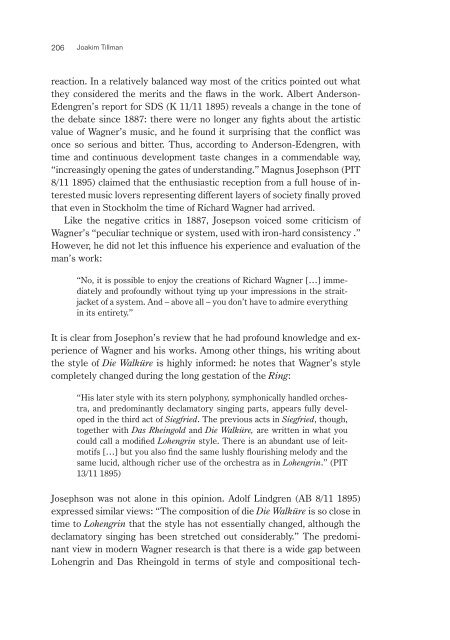Opera on the Move in the Nordic Countries during the Long 19th ...
Opera on the Move in the Nordic Countries during the Long 19th ...
Opera on the Move in the Nordic Countries during the Long 19th ...
You also want an ePaper? Increase the reach of your titles
YUMPU automatically turns print PDFs into web optimized ePapers that Google loves.
206 Joakim Tillman<br />
reacti<strong>on</strong>. In a relatively balanced way most of <strong>the</strong> critics po<strong>in</strong>ted out what<br />
<strong>the</strong>y c<strong>on</strong>sidered <strong>the</strong> merits and <strong>the</strong> flaws <strong>in</strong> <strong>the</strong> work. Albert Anders<strong>on</strong>-<br />
Edengren’s report for SDS (K 11/11 1895) reveals a change <strong>in</strong> <strong>the</strong> t<strong>on</strong>e of<br />
<strong>the</strong> debate s<strong>in</strong>ce 1887: <strong>the</strong>re were no l<strong>on</strong>ger any fights about <strong>the</strong> artistic<br />
value of Wagner’s music, and he found it surpris<strong>in</strong>g that <strong>the</strong> c<strong>on</strong>flict was<br />
<strong>on</strong>ce so serious and bitter. Thus, accord<strong>in</strong>g to Anders<strong>on</strong>-Edengren, with<br />
time and c<strong>on</strong>t<strong>in</strong>uous development taste changes <strong>in</strong> a commendable way,<br />
“<strong>in</strong>creas<strong>in</strong>gly open<strong>in</strong>g <strong>the</strong> gates of understand<strong>in</strong>g.” Magnus Josephs<strong>on</strong> (PIT<br />
8/11 1895) claimed that <strong>the</strong> enthusiastic recepti<strong>on</strong> from a full house of <strong>in</strong>terested<br />
music lovers represent<strong>in</strong>g different layers of society f<strong>in</strong>ally proved<br />
that even <strong>in</strong> Stockholm <strong>the</strong> time of Richard Wagner had arrived.<br />
Like <strong>the</strong> negative critics <strong>in</strong> 1887, Joseps<strong>on</strong> voiced some criticism of<br />
Wagner’s “peculiar technique or system, used with ir<strong>on</strong>-hard c<strong>on</strong>sistency .”<br />
However, he did not let this <strong>in</strong>fluence his experience and evaluati<strong>on</strong> of <strong>the</strong><br />
man’s work:<br />
“No, it is possible to enjoy <strong>the</strong> creati<strong>on</strong>s of Richard Wagner […] immediately<br />
and profoundly without ty<strong>in</strong>g up your impressi<strong>on</strong>s <strong>in</strong> <strong>the</strong> straitjacket<br />
of a system. And – above all – you d<strong>on</strong>’t have to admire everyth<strong>in</strong>g<br />
<strong>in</strong> its entirety.”<br />
It is clear from Joseph<strong>on</strong>’s review that he had profound knowledge and experience<br />
of Wagner and his works. Am<strong>on</strong>g o<strong>the</strong>r th<strong>in</strong>gs, his writ<strong>in</strong>g about<br />
<strong>the</strong> style of Die Walküre is highly <strong>in</strong>formed: he notes that Wagner’s style<br />
completely changed dur<strong>in</strong>g <strong>the</strong> l<strong>on</strong>g gestati<strong>on</strong> of <strong>the</strong> R<strong>in</strong>g:<br />
“His later style with its stern polyph<strong>on</strong>y, symph<strong>on</strong>ically handled orchestra,<br />
and predom<strong>in</strong>antly declamatory s<strong>in</strong>g<strong>in</strong>g parts, appears fully developed<br />
<strong>in</strong> <strong>the</strong> third act of Siegfried. The previous acts <strong>in</strong> Siegfried, though,<br />
toge<strong>the</strong>r with Das Rhe<strong>in</strong>gold and Die Walküre, are written <strong>in</strong> what you<br />
could call a modified Lohengr<strong>in</strong> style. There is an abundant use of leitmotifs<br />
[…] but you also f<strong>in</strong>d <strong>the</strong> same lushly flourish<strong>in</strong>g melody and <strong>the</strong><br />
same lucid, although richer use of <strong>the</strong> orchestra as <strong>in</strong> Lohengr<strong>in</strong>.” (PIT<br />
13/11 1895)<br />
Josephs<strong>on</strong> was not al<strong>on</strong>e <strong>in</strong> this op<strong>in</strong>i<strong>on</strong>. Adolf L<strong>in</strong>dgren (AB 8/11 1895)<br />
expressed similar views: “The compositi<strong>on</strong> of die Die Walküre is so close <strong>in</strong><br />
time to Lohengr<strong>in</strong> that <strong>the</strong> style has not essentially changed, although <strong>the</strong><br />
declamatory s<strong>in</strong>g<strong>in</strong>g has been stretched out c<strong>on</strong>siderably.” The predom<strong>in</strong>ant<br />
view <strong>in</strong> modern Wagner research is that <strong>the</strong>re is a wide gap between<br />
Lohengr<strong>in</strong> and Das Rhe<strong>in</strong>gold <strong>in</strong> terms of style and compositi<strong>on</strong>al tech-
















